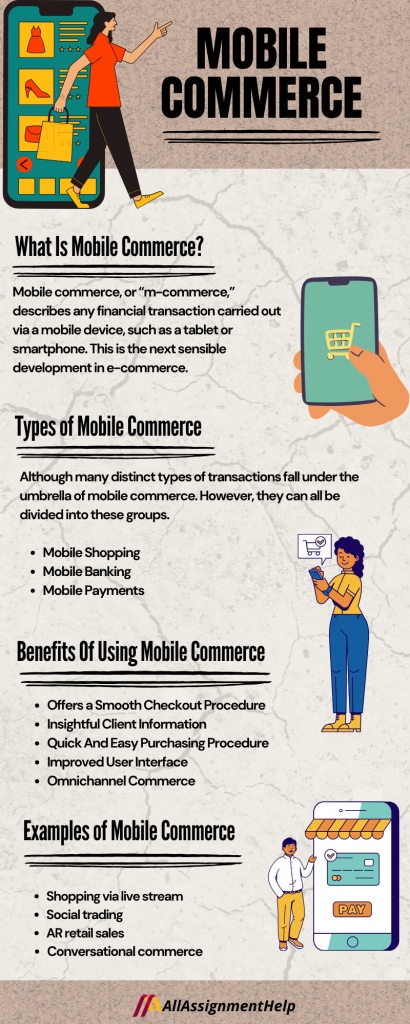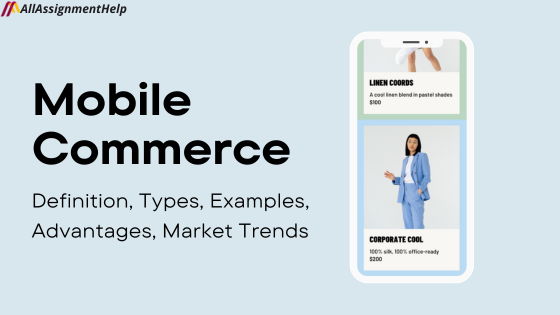Table of Contents
Several retail and e-commerce firms have been pushing the adoption of more mobile-centric strategies due to the rapid rise of mobile devices and the widespread use of internet services. It’s not simply a means of getting in touch with your loved ones. However, it’s also a crucial route for businesses to interact with their target market. People are more inclined to make purchases using mobile devices, websites, and apps due to the convenience of mobile commerce and its expanding popularity.
A lot of companies are launching their applications, and customers are prepared to accept using their mobile devices to make online purchases. Now, the topic has also been included in the study of students which is why many of them search for reliable sources where they can gather enough information about what is mobile commerce. Therefore, the experts at All Assignment Help have created this blog where you will get every necessary information you need to know about M-commerce.
What Is Mobile Commerce?
Mobile commerce, or “m-commerce,” describes any financial transaction carried out via a mobile device, such as a tablet or smartphone. This is the next sensible development in e-commerce. This is so that anyone with a mobile device and an internet connection may purchase and sell goods and services from almost anywhere.
However, m-commerce is more than just an advancement of e-commerce. In reality, it has helped in the expansion of numerous sectors and given rise to fresh ventures and offerings, such as:
- Acquisition and distribution of digital content
- Services based on location
- Mobile discounts, loyalty programs, and advertising
- Banking on the go
- Contactless payments and in-app purchases
- Boarding passes and tickets in electronic form
- Money transfers via mobile devices
Read Here: Computer Technology- Meaning, Significance and Career Opportunities
Types of Mobile Commerce
Although many distinct types of transactions fall under the umbrella of mobile commerce. However, they can all be divided into these groups.
Mobile Shopping
The success of mobile shopping is largely dependent on the mobile device. However, modern consumers demand an omnichannel experience; they want their companies to be accessible through their favorite channels. For example, customers can use the Viber Chatbot to continue their purchasing if they scan a QR code in a physical store.
Mobile Banking
Mobile banking is also referred to as “Net Banking.” Banks in particular employ chatbots, apps, and SMS to communicate account activity and alerts. Customers can communicate via WhatsApp in real-time to examine their account balance, bank statement, fund transfer, evaluate loans, and many other transactions with the help of the WhatsApp Chatbot.
Mobile Payments
Also referred to as mobile money transfer, mobile money, or m-payments, mobile payments are an alternative to more conventional payment methods including cash, checks, and credit/debit cards. Customers prefer to use contactless payments due to physical distance, which is where mobile payments come in handy.
However, you can learn more about these types of mobile commerce by taking an online course. There are a variety of online classes available in which you can enroll yourself just by paying a minimal cost. Furthermore, when you find yourself struggling with your online classes and need someone to help you with it, you can google “Where should I pay someone to take my online class for me?” and you will find a lot of services that offer online class help to students.

What Are Some Examples of Mobile Commerce?
Buying things with your phone is not the only aspect of mobile commerce. Any purchase made through an app or mobile browser comes within the larger concept of mobile commerce. This comprises:
- Shopping via live stream: Where users purchase products by watching live on Facebook, Instagram, or Amazon
- Social trading: Investigating or purchasing goods straight from social media advertisements or posts
- AR retail sales: Utilizing camera apps to sample goods in virtual environments (e.g., the EyeBuyDirect app for virtual glasses try-ons or the IKEA app for furnishings)
- Conversational commerce: using mobile representatives to complete transactions (via chat apps or social media)
Students who are writing assignments on m-commerce need to understand the various examples. Including such examples can bring more validity to their assignments. However, there are many online assignment help services available on the Internet that can help you write your mobile commerce assignments with credible and accurate examples.
Benefits Of Using Mobile Commerce
Knowing the benefits of mobile commerce is essential to use critical thinking to identify the elements that can transform obstacles into opportunities. The prominent benefits of using mobile commerce are as follows:
Offers a Smooth Checkout Procedure
The process of completing a transaction takes a little longer when someone purchases from a standard website. However, if a consumer uses Viber Business Messages for the transaction, the lengthy checkout process is reduced and the checkout process is completed smoothly.
Insightful Client Information
Mobile commerce can gather client information and provide a deeper understanding of the customer journey. In traditional retail, consumers visit the store, make a purchase, and then depart. This is known as brick-and-mortar retail. Very few specifics, such as the reasons behind their purchases, are recorded and kept for statistics and analysis.
Quick And Easy Purchasing Procedure
Customers no longer need to wait in line to pay for an item at a store or to use a computer. With their mobile device, individuals can browse products that catch their eye and make purchases. Increased conversions on your website can be achieved with a good mobile experience.
Improved User Interface
Improving user experience has the potential to convert new leads into loyal ones. Customers can check what they wish to get and check out whenever it’s convenient for them by logging into the app. Furthermore, M-commerce can also encourage customers to make impulsive purchases by providing them with a variety of flash sales that are disseminated via push notifications or customized messages.
Omnichannel Commerce
The main goal of omnichannel advertising is to reach your customers where they are and streamline the purchasing process. You may further improve your omnichannel strategy with mobile devices as customers always have their phones with them. Moreover, omnichannel commerce tends to change the world of mobile commerce.
Mobile commerce gives businesses a big competitive edge, whether they are launching a new product or trying to create a network design proposal. Moreover, gaining more market share can be facilitated by utilizing the access and client data that mobile commerce offers.
Mobile Commerce Vs E-commerce
There are some significant distinctions between m- and e-commerce, despite their many similarities. To gain further insight, let’s take a closer look at these layers.
E-commerce is the term used to describe virtually any business transaction conducted online. However, digital transactions conducted through smartphones are especially referred to as m-commerce. Therefore, E-commerce is defined as the process of purchasing while using a desktop computer to browse a shoe website. M-commerce occurs when you use a smartphone to browse and buy from the same website.
To put it briefly, mobile commerce (m-commerce) enables customers to use a mobile device to browse, purchase, and access online shopping platforms as easily and conveniently as possible.
Mobile and E-commerce both are parts of economics study. Hence, taking an online economics class can help you understand the relationship between the two in a far better way. Therefore, it is suggested that you should pay someone to take your online economics class to get the most out of your economics classes.
Important Market Trends and Statistics Related to Mobile Commerce
Here are some current statistics on m-commerce to show how popular smartphone purchasing is and why it’s so important for brands.
- 82.2% of all retail m-commerce sales in the US will come from smartphone shopping in 2024, with $295.41 billion in sales expected. Furthermore, it is just not affordable for businesses to ignore their mobile presence when there is about $300 billion at stake.
- Mobile devices account for 55% of all online traffic, meaning that smartphone traffic is still surpassing that of desktop computers. This could be enlightening for those of us who buy virtually solely on desktops.
- Sales of mobile commerce increased 41.4% in the US in 2023 alone. Mobile commerce exploded during the COVID-19 epidemic, ranging from necessities and supermarket orders to retail therapy and beyond.
- By 2024, mobile will account for more than half of all retail e-commerce sales in Latin America. This should come as no surprise considering that 90% of people on the planet carry cellphones.
Without question, m-commerce is more than a trend. As smartphones become more and more essential to how customers connect, get information, and now shop online, mobile shopping will probably stop being an option and start becoming a requirement for e-commerce companies.
Also Read: Logistics in the eCommerce Industry
The Final Words!
Undoubtedly, mobile commerce is becoming more and more popular. More customers discover every day that m-commerce is the most practical and effective form of internet shopping. This implies that companies will be in a better position to provide the optimum user experience if they stay up to date with new developments in mobile commerce. However, if you are a student and need someone who can do my assignment on m-commerce, you can connect with us online and we will match you with the finest expert to do your mobile commerce assignment.
FAQs
| How big is the m-commerce market? The “Mobile Commerce Market” gives companies a stage on which to compete and develop by offering products and services that cater to a broad spectrum of client demands. It is essential to the economy as a whole and significantly promotes development and progress. |
| What is necessary for mobile commerce? The capacity of a mobile commerce app to draw in and hold on to users determines its level of success. Therefore, it is essential to take into account the features and functionalities that users would find most beneficial. |
| What kind of technology is being used in mobile commerce? Wireless Access Protocol (WAP), Unstructured Supplementary Service Data (USSD), and SMS are the three protocols available. In addition, the SIM Toolkit (STK) helps you add new functionality to feature phones. The most popular and oldest of these technologies is text messaging or SMS. |
